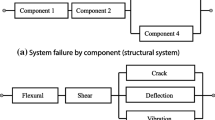Abstract
The brief review of the quality control system for complex technical systems is given. A generalizing condition for the analysis and control of safety as the basis for quality control of any complex technical system based on the risk theory has been adopted. The technical risk analysis cannot always adequately evaluate the safety of the structure, so the transition from technical risk to the structural risk of complex technical systems is shown. As an example of such systems, it is proposed to investigate cranes casting bridge type, operating in heavy and superheavy operation modes. Four blocks (subsystems) of the first level of structural risk and ten elements of the second level have been singled out. On the basis of the evolving structural risk theory, its meaningful formulation for complex metallurgical systems is given. A model of structural risk coordinated by goals and tasks has been constructed. The evaluation of structural risk as the probability of catastrophic destruction of a group of objects, metallurgical bridge cranes, will allow one to formulate and analytically determine the parameters of their quality control from the position of safety and reliability.
Access this chapter
Tax calculation will be finalised at checkout
Purchases are for personal use only
Similar content being viewed by others
References
Izvekov YuA (2012) Modelirovanie prognozirovaniya riska nesushchikh konstruktsiy kranov metallurgicheskogo proizvodstva (Model operation of prediction of risk of load-bearing frames of cranes of metallurgical production). Curr Probl Mod Sci Tech Educ 70:6–8
Izvekov YuA (2013) Risk-analiz oborudovaniya metallurgicheskikh proizvodstv. Podkhod, kontseptsiya, analiz (Risk analysis of an inventory of metallurgical productions. Approach, concept, analysis). Saarbrucken, Deutschland
Frolov KV, Makhutov NA (2006) Bezopasnost Rossii. Pravovye, sotsialno-ekonomicheskie i nauchno-tekhnicheskie aspekty (Safety of Russia. Legal, socio-economic, and scientific and technical aspects). In: 4 parts. part 1: the basic concepts of the analysis and regulation of safety. Znanie, Moscow
Anon (1989) Risk criteria for land use planning in the vicinity of major industrial hazards. U.K. Health and Safety Executive, London
Anon (1993) Risk analysis, perception, management. The Royal Society, London
Bagrov AV, Murtazov AK (2010) Tekhnogennye sistemy i teoriya riska (Technogenic systems and risk theory). Ryazan State University named for S.A. Yesenin, Ryazan
Biryukov MP (1980) Dinamika i prognoziruyushchiy raschet mekhanicheskikh sistem (Dynamics and the predicting calculation of mechanical systems). Vysheyshya shkola, Minsk
Boulding KE (1956) General systems theory—the skeleton of science. Manage Sci 2:197–208
Brushlinsky NN, Hall JR, Sokolov SV, Wagner P (2003) Fire statistics, June 2003. Academy of State Fire Service, Moscow
Taguchi G (1985) Quality engineering in Japan. Bull Jpn Soc Precis Eng 4:237–242
Hammad DB, Shafiq N, Nuruddin MF (2014) Criticality index of building systems using multi-criteria decision analysis technique. MATEC Web Conf EDP Sci 15:01018
Izvekov YuA (2012) Analiz tekhnogennoy bezopasnosti kranovogo khozyaystva Rossii (Analysis of technogenic safety of crane economy of Russia). Mod High Technol 12:18–19
Kumamoto H, Henley EJ (1996) Probabilistic risk assessment and management for engineers and scientists. IEEE Press, New York
Lepikhin AM (2000) Risk analysis of designs of potentially dangerous objects on the basis of probability models of mechanics of destruction. Dissertation, RAS, Siberian Office, Institute of Computing Model Operation, Krasnoyarsk
Malinetsky GG, Potapov AB (2000) Sovremennye problemy nelineynoy dinamiki (The modern problems of non-linear dynamics). Editorial of URSS, Moscow
Sorensen AG (1973) A statistical analysis of product reliability due to random vibration. In: Proceedings of annual reliability and maintainability symposium, Philadelphia
Stepanov VV (2006) Kurs differentsialnykh uravneniy (The course of the differential equations). KomKniga, Moscow
Bezopasnost truda v promyshlennosti (Safety of work in the industry) (2010). Moscow
Gilmore R (1993) Catastrophe theory for scientists and engineers. Dover, New York
Poston T, Stewart I (1998) Catastrophe: theory and its applications. Dover, New York
Prigozhin I, Stengers I (1994) Poryadok iz khaosa. Vremya, khaos, kvant (Order out of chaos. Time, chaos, quantum). Progress, Moscow
Sanns W (2000) Catastrophe theory with mathematica: a geometric approach. DAV, Germany
Saunders PT (1980) An introduction to catastrophe theory. Cambridge University Press, Cambridge
Thompson J, Michael T (1982) Instabilities and catastrophes in science and engineering. Wiley, New York
Izvekov YuA, Kobelkova EV, Loseva NA, Dubrovsky VV, Khamutskikh EYu (2015) Mathematical evaluation of mechanical construction safe loading. J Ind Pollut Control 1:115–118
Gugina EM (2017) Raschet nadezhnosti mostovykh kranov metodom preobrazovaniya veroyatnostey (Calculation of reliability of bridge cranes by method of transformation of probabilities). In: Technical sciences: problems and prospects. Materials of the fifth international scientific conference, St. Petersburg, July 2017. Svoyo izdatelstvo, St. Petersburg, pp 68–70
Author information
Authors and Affiliations
Corresponding author
Editor information
Editors and Affiliations
Rights and permissions
Copyright information
© 2019 Springer Nature Switzerland AG
About this paper
Cite this paper
Izvekov, Y.A., Gugina, E.M., Shemetova, V.V. (2019). Structural Risk Analysis as Basis for Quality Control of Metallurgical Systems. In: Radionov, A., Kravchenko, O., Guzeev, V., Rozhdestvenskiy, Y. (eds) Proceedings of the 4th International Conference on Industrial Engineering. ICIE 2018. Lecture Notes in Mechanical Engineering. Springer, Cham. https://doi.org/10.1007/978-3-319-95630-5_182
Download citation
DOI: https://doi.org/10.1007/978-3-319-95630-5_182
Published:
Publisher Name: Springer, Cham
Print ISBN: 978-3-319-95629-9
Online ISBN: 978-3-319-95630-5
eBook Packages: EngineeringEngineering (R0)




